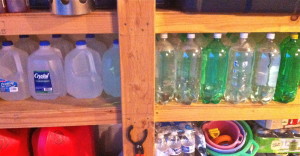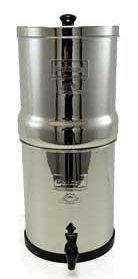I woke up the other day and shuffled over to the toilet. As I prepared to go, I noticed the water was off-color; not terrible discolored, but not clear. After I flushed, the water was still off-color. I lifted the lid off the tank and nothing seemed amiss there. I went and looked at the downstairs toilet, it was also discolored. I began to get concerned.
I know that the water that goes into the toilet comes from the same source as water that goes to the sink, and since the toilet water didn’t look right I became worried about our drinking water. As a list of possible problems, and back-up water solutions, went through my head I mentioned it to Sarah. She casually reminded me that there had been signs up around the neighborhood that they were going to be flushing the water lines, and it was probably related to that. I flushed the toilet a few times, ran the sink for a little while, and they both again ran clear. Crisis averted (more like never existed).
BUT, this made me reflect on one of our most important basic needs: clean drinking water. It was nice to know that our family is prepared for this type of emergency, we have:
 over 50 gallons of water stored in the garage (most in repurposed 2-liter soda bottles, which can also be reused for solar disinfection).
over 50 gallons of water stored in the garage (most in repurposed 2-liter soda bottles, which can also be reused for solar disinfection).- two 50-gallon barrels of water in the backyard.
- two 50-gallon rain barrels in the backyard. We use these regularly, but here in Western WA they stay filled pretty well.
 a Berkey family size water filter
a Berkey family size water filter- a small pond a block away (and 5-gallon water cans for collection/transport)
- several unopened gallons of bleach
- a 50-gallon water heater
- extra fuel to boil water
Restating from one of my early posts, But Water Is Heavy!, “. . . you can only live three to four days without access to clean drinking water. The ‘average’ adult human body is composed of approximately 60% water, the brain 75%.
“Before a disaster strikes, water is an easy thing to acquire and store. It is cheap and available. To get your recommended three-day emergency supply, you can buy commercially bottled water for less than $1 a gallon. Do the math for what is needed for your family, spend the money and put it somewhere safe and you’re done. If you want to fill your own: use clean, food-grade, plastic containers. Two-liter soda bottles work very well, avoid using milk jugs (they’re not meant for longer storage). If the containers are clean and the water is clean there is no need to add bleach.”
The first thing you should do, when you begin to prepare–before you do anything else–is to store water.

I found an article you might find interesting.
http://who.int/features/factfiles/water/en/
I was researching my podcast on Hazmat, when I came across an offical statement from the FDA. Do you know they have a list of drugs, YOU SHOULD flush down the toilet. How messed up this that?!?
Interesting article. Another reason to appreciate the fact that we can (for now) just turn on the faucet and clean water comes out — as much as we want.
But having a backup plan, especially for water, is a must for everyone.
Just found your site, looks well organized – nice work. My question is, how often do you recycle your water (if at all)? And, if you don’t, what would your plan be for preparing to use water that had been sitting for a very extended period of time – boiling, filtering, something else, nothing at all?
Thanks.
Good question. There’s a common misconception that water goes bad, but it doesn’t. If you put water in a clean container, it stays clean. Now if the container is open, or there’s contaminates inside, then bacteria will grow. So assuming the container and the water were clean, the water will stay clean — but it does go “flat”. I’ve found the best way to deal with this flat, stale taste it simply introduce more air into the water; simply pouring it into another container so it splashes will help revitalize it and it will taste better. But regardless the water is perfectly good, healthy, and drinkable.
Water from my rain barrels is another question, they are open and the water that runs off the roof isn’t the cleanest. Sure it’d be just fine for washing, but before I drink it I’d filter it. I own, and highly recommend, a Berkey water filter system, it does a good job, lasts a long time, and is easy to maintain. We live in Western WA, we have plenty of water but there needs to be a plan in place to filter/purify it. As a backup we also store chlorine tablets that you’d use in a pool, with the plan to mix them with water into a solution, then use them as a disinfectant to purify water (remember bleach is only good for about a year).
Do you have any suggestions for persons that live in small apartments or townhomes. We do not have a garage or any indoors storage area. What do you think about storing water outside under a tarp?
I don’t think there’s any problem storing water outdoors. I’d suggest 5, 15, or even 50 gallon, food grade, storage containers that seal well. Once you get your containers, fill them with clean water (no need to treat with bleach) and store them outside in a safe place.